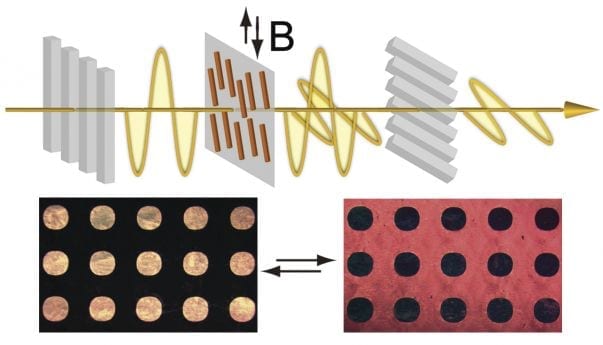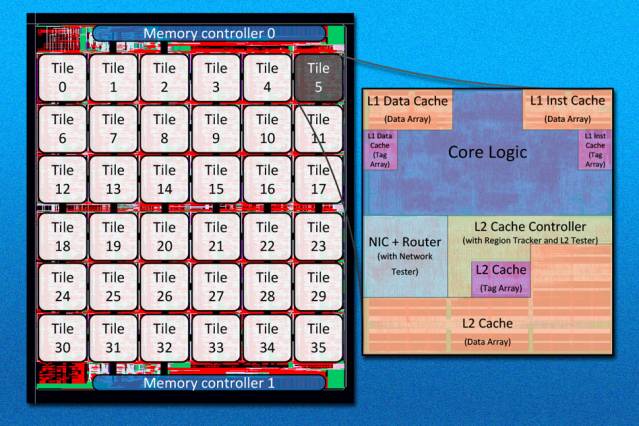
The discovery has applications in signage, posters, writing tablets, billboards and anti-counterfeit technology
Chemists at the University of California, Riverside have constructed liquid crystals with optical properties that can be instantly and reversibly controlled by an external magnetic field. The research paves the way for novel display applications relying on the instantaneous and contactless nature of magnetic manipulation—such as signage, posters, writing tablets, and billboards.
Commercially available liquid crystals, used in modern electronic displays, are composed of rod-like or plate-like molecules. When an electric field is applied, the molecules rotate and align themselves along the field direction, resulting in a rapid tuning of transmitted light.
“The liquid crystals we developed are essentially a liquid dispersion, a simple aqueous dispersion of magnetic nanorods,” said Yadong Yin, an associate professor ofchemistry, who led the research project. “We use magnetic nanorods in place of the commercial nonmagnetic rod-like molecules. Optically these magnetic rods work in a similar way to commercial rod-like molecules, with the added advantage of being able to respond rapidly to external magnetic fields.”
Yin explained that upon the application of a magnetic field, the nanorods spontaneously rotate and realign themselves parallel to the field direction, and influence the transmittance of polarized light.
“Prior attempts had been limited to materials with very limited magnetic responses,” Yin said. “We utilized our expertise in colloidal nanostructure synthesis to produce magnetite nanorods that can form liquid crystals and respond strongly to even very weak magnetic fields – even a fridge magnet can operate our liquid crystals.”
Read more . . .
The Latest on: Magnetically Responsive Liquid Crystals
[google_news title=”” keyword=”Magnetically Responsive Liquid Crystals” num_posts=”10″ blurb_length=”0″ show_thumb=”left”]
via Google News
The Latest on: Magnetically Responsive Liquid Crystals
- Magnetic Nanoparticle-based Approaches to Locally Target Therapy and Enhance Tissue Regeneration in vivoon May 3, 2024 at 5:01 pm
Possible methods for magnetic delivery and release of GFs include: attraction of MNP loaded with GFs to a magnetically responsive scaffold ... Individual magnetite crystals in the size range ...
- Spigen Liquid Crystal Samsung Galaxy S24 case review: Should you buy it?on April 4, 2024 at 5:00 pm
The Spigen Liquid Crystal nails the basics of a thin clear case, with a price point that's difficult to resist. To be clear, Spigen hasn’t reinvented the wheel here. There’s nothing ...
- Liquid Crystal Nanoparticles: Merging the Worlds of Liquid Crystals and Nanotechnologyon April 1, 2024 at 7:39 pm
What are Liquid Crystal Nanoparticles? Liquid crystal nanoparticles (LCNPs ... imaging agents, or stimuli-responsive moieties. The release of the encapsulated drugs can be triggered by external ...
- A novel liquid crystal-based tunable dielectric metasurfaceon April 1, 2024 at 1:42 pm
In a study published in the journal Advanced Devices & Instrumentation, Professor Daping Chu's team at the University of Cambridge developed a novel liquid crystal-based tunable dielectric ...
- Scientists open new realm of efficient solar energy technology with latest research: 'Pushing the boundaries'on March 14, 2024 at 9:24 am
The crystals would stay liquid when the perovskites are solid, helping to move a charge through the material. Heat-responsive liquid crystals have been previously studied for other applications in ...
- Liquid crystal on siliconon February 29, 2024 at 6:36 pm
More than $2 billion has been spent over the past 15 years in trying to develop the technology and infrastructure behind liquid-crystal-on-silicon (LCoS) displays. After a fitful start ...
- Liquid Crystals and their Computer Simulationson June 8, 2023 at 12:36 am
Ilnytskyi, Jaroslav Yaremchuk, Dmytro and Komarytsia, Orest 2023. Adsorption of Low Density Lipoproteins on an Azobenzene-Containing Polymer Brush: Modelling by ...
- Controlling thermal conductivity in liquid crystalson April 16, 2023 at 5:00 pm
(b) Phase diagram of the 4,4′-dialkyloxy-3-methylazobenzene derivatives with the number of C-atoms in the alkyl chain; N-LC and IL refer to nematic liquid crystal and isotropic liquid, respectively.
- Magnetically Actuated Liquid Crystals (IMAGE)on September 10, 2022 at 10:29 pm
Top: Scheme showing magnetic control over light transmittance in the novel liquid crystals. B is the alternating magnetic field. The polarized light is seen in yellow. The gray rods represent the ...
- Liquid Crystals and their Computer Simulationson August 26, 2022 at 7:37 am
Roscioni, Otello Maria Ricci, Matteo Zannoni, Claudio and D’Avino, Gabriele 2023. Are Coarse-Grained Structures as Good as Atomistic Ones for Calculating the Electronic Properties of Organic ...
via Bing News









